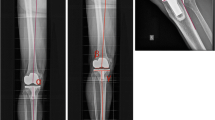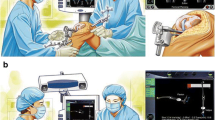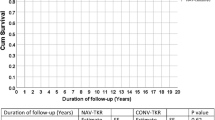Abstract
Purpose
There remains controversy as to whether computer-navigated total knee replacement (TKR) improves the overall prosthesis alignment and patient function. The aim of this study was to determine whether computer-assisted total knee arthroplasty provides superior prosthesis positioning when compared to a conventional jig-assisted total knee replacement and whether this affected the functional outcome.
Methods
This prospective, randomised controlled study compared computer navigated and conventional jig-assisted total knee replacement in 37 patients who underwent bilateral TKR. A quantitative assessment of the spatial positioning of the implant in the 74 total knee replacements was determined using a low-dose dual-beam CT scanning technique. This resulted in six parameters of alignment that were compared. Functional outcomes using the high activity arthroplasty score and Knee Society score were assessed pre-operatively, postoperatively, at three years and at five years. Patients also indicated which knee they felt was subjectively the best.
Results
There was no statistically significant difference in the prosthesis alignment between both groups and the number of outliers was not decreased with navigation. All function scores improved from pre-operative to postoperative but there was no statistically significant difference between the groups at five years. At five years, 40.6 % of patients thought their jig-assisted knee was the better knee compared with 21.9 % their computer assisted knee and 37.5 % of patients who felt they were the same.
Conclusion
Computer-assisted implantation of total knee replacements does not offer a significant advantage in prosthesis alignment. There was no difference in functional outcome or subjective “best knee” between the computer-assisted or jig-assisted knee.





Similar content being viewed by others
References
Wasiliewski RC et al (1995) Wear patterns on retrieved polyethylene inserts and their relationship to technical considerations during total knee arthroplasty. Clin Orthop 318:176–181
Moreland JR (1988) Mechanisms of failure in total knee arthroplasty. Clin Orthop Relat Res 266:49–64
Lotke PA, Ecker ML (1977) Influence of positioning of prosthesis in total knee replacement. J Bone Joint Surg Am 59:77–79
Ritter MA et al (1994) Postoperative alignment of total knee replacement. Its effect on survival. Clin Orthop Relat Res 299:153–156
Berend ME et al (2004) Tibial component failure mechanisms in total knee arthroplasty. Clin Orthop Relat Res 428:26–34
Jeffery RS et al (1991) Coronal alignment after total knee replacement. J Bone Joint Surg Br 73:709–714
Rienmüller A, Guggi T, Gruber G, Preiss S, Drobny T (2012) The effect of femoral component rotation on the five-year outcome of cemented mobile bearing total knee arthroplasty. Int Orthop 36(10):2067–2072
Choong PF, Dowsey MM, Stoney JD (2009) Does accurate anatomical alignment result in better function and quality of life? comparing conventional and computer-assisted total knee arthroplasty. J Arthroplasty 24:560–569
Sparman M et al (2003) Positioning of total knee arthroplasty with and without navigation support. A prospective, randomised study. J Bone Joint Surg Br 85:830–835
Stulberg SD et al (2002) Computer-assisted navigation in total knee replacement: results of an initial experience in thirty-five patients. J Bone Joint Surg Am 84(Suppl 2):90–98
Chin PL et al (2005) Randomised control trial comparing radiographic total knee arthroplasty implant placement using computer navigation versus conventional technique. J Arthroplasty 20:618–626
Bathis H et al (2004) Alignment in total knee arthroplasty. A comparison of computer-assisted surgery with the conventional technique. J Bone Joint Surg Br 86:682–687
Haaker RG, Stockheim M, Kamp M, Proff G, Breitenfelder J, Ottersbach A (2005) Computer-assisted navigation increases precision of component placement in total knee arthroplasty. Clin Orthop Relat Res 433:152–159
Chauhan S, Scott R, Breidahl W, Beaver R (2004) Computer-assisted knee arthroplasty versus a conventional jig-based technique: a randomised, prospective trial. J Bone Joint Surg Br 86-B:372–377
Zhang G, Chen J, Chai W, Liu M, Wang Y (2011) Comparison between computer-assisted-navigation and conventional total knee arthroplasties in patients undergoing simultaneous bilateral procedures—a randomized clinical trial. J Bone Joint Surg Am 93(13):1190–1196
Mason J, Fehring T, Estok R, Banel D, Fahrbach K (2007) Meta-analysis of alignment outcomes in computer-assisted total knee arthroplasty surgery. J Arthroplasty 22(8):1097–1106
Yi-Jan Weng MD, Robert Wen-Wei Hsu MD, Wei-Hsiu Hsu MD (2009) Comparison of computer-assisted navigation and conventional instrumentation for bilateral total knee arthroplasty. J Arthroplasty 24(5):668–673
Kim Y, Kim J, Choi Y, Kwon O (2009) Computer-assisted surgical navigation does not improve the alignment and orientation of the components in total knee arthroplasty. J Bone Joint Surg Am 91(1):14–19
Parratte S, Pagnano MW, Trousdale RT, Berry DJ (2010) Effect of postoperative mechanical axis alignment on the fifteen-year survival of modern, cemented total knee replacements. J Bone Joint Surg Am 92(12):2143–2149
Kim YH, Park JW, Kim JS (2012) Computer-navigated versus conventional total knee arthroplasty. A prospective randomized trial. J Bone Joint Surg Am 94:2017–2024
Cinotti G, Ripani F, Sessa P, Giannicola G (2012) Combining different rotational alignment axes with navigation may reduce the need for lateral retinacular release in total knee arthroplasty. Int Orthop 36(8):1595–1600
Saragaglia D, Picard F, Chaussard C, Montbarbon E, Leitner F, Cinquin P (2001) Computer-assisted knee arthroplasty: comparison with a conventional procedure. Results of 50 cases in a prospective randomized study. Rev Chir Orthop Reparatrice Appar Mot 87(1):18–28
Koshino T, Takeyama M, Jiang LS, Yoshida T, Saito T (2002) Underestimation of varus angulation in knees with flexion deformity. Knee 9:275–279
Krackow KA, Pepe CL, Galloway EJ (1990) A mathematical analysis of the effect of flexion and rotation on apparent varus/valgus alignment at the knee. Orthopaedics 13:861–868
Kawakami H, Sugano N, Yonenobu K, Yoshikawa H, Ochi T, Hattori A, Suzuki N (2004) Effects of rotation on measurement of lower limb alignment for knee osteotomy. J Othop Res 22:1248–1253
Henckel J, Richards R, Lozhkin K, Harris S, Baena FM R y, Barret ARW, Cobb JP (2006) Very low-dose computed tomography for planning and outcome measurement in knee replacement—the imperial knee protocol. J Bone Joint Surg Br 88-B:1513–1518
Chauhan SK, Clark GW, Lloyd S, Scott RG, Breidahl W, Sikorski JM (2004) Computer-assisted total knee replacement. A controlled cadaver study using a multi-parameter quantitative CT assessment of alignment (The Perth CT protocol). J Bone Joint Surg Br 86-B:818–823
Matziolis G, Krocker D, Weiss U, Tohtz S, Perka C (2007) A prospective, randomised study of computer-assisted and conventional total knee arthroplasty. Three dimensional evaluation of implant alignment and rotation. J Bone Joint Surg Am 89:236–243
Talbot S, Hooper G, Stokes A, Zordan R (2010) Use of a new high-activity arthroplasty score to assess function of young patients with total hip or knee arthroplasty. J Arthroplasty 25(2):268–273
Armitage P, Berry G, Mathews J (2002) Statistical methods in medical research. Oxford, Blackwell
Tigani D, Masetti G, Sabbioni G, Ben Ayad R, Filanti M, Fosco M (2012) Computer-assisted surgery as indication of choice: total knee arthroplasty in case of retained hardware or extra-articular deformity. Int Orthop 36(7):1379–1385
Ritter M, Davis K, Davis P, Farris A, Malinzak R, Berend M, Meding J (2013) Preoperative malalignment increases risk of failure after total knee arthroplasty. J Bone Joint Surg Am 95(2):126–131
Conflict of interest
There are no conflicts of interest.
Author information
Authors and Affiliations
Corresponding author
Rights and permissions
About this article
Cite this article
Allen, C.L., Hooper, G.J., Oram, B.J. et al. Does computer-assisted total knee arthroplasty improve the overall component position and patient function?. International Orthopaedics (SICOT) 38, 251–257 (2014). https://doi.org/10.1007/s00264-013-1996-0
Received:
Accepted:
Published:
Issue Date:
DOI: https://doi.org/10.1007/s00264-013-1996-0




